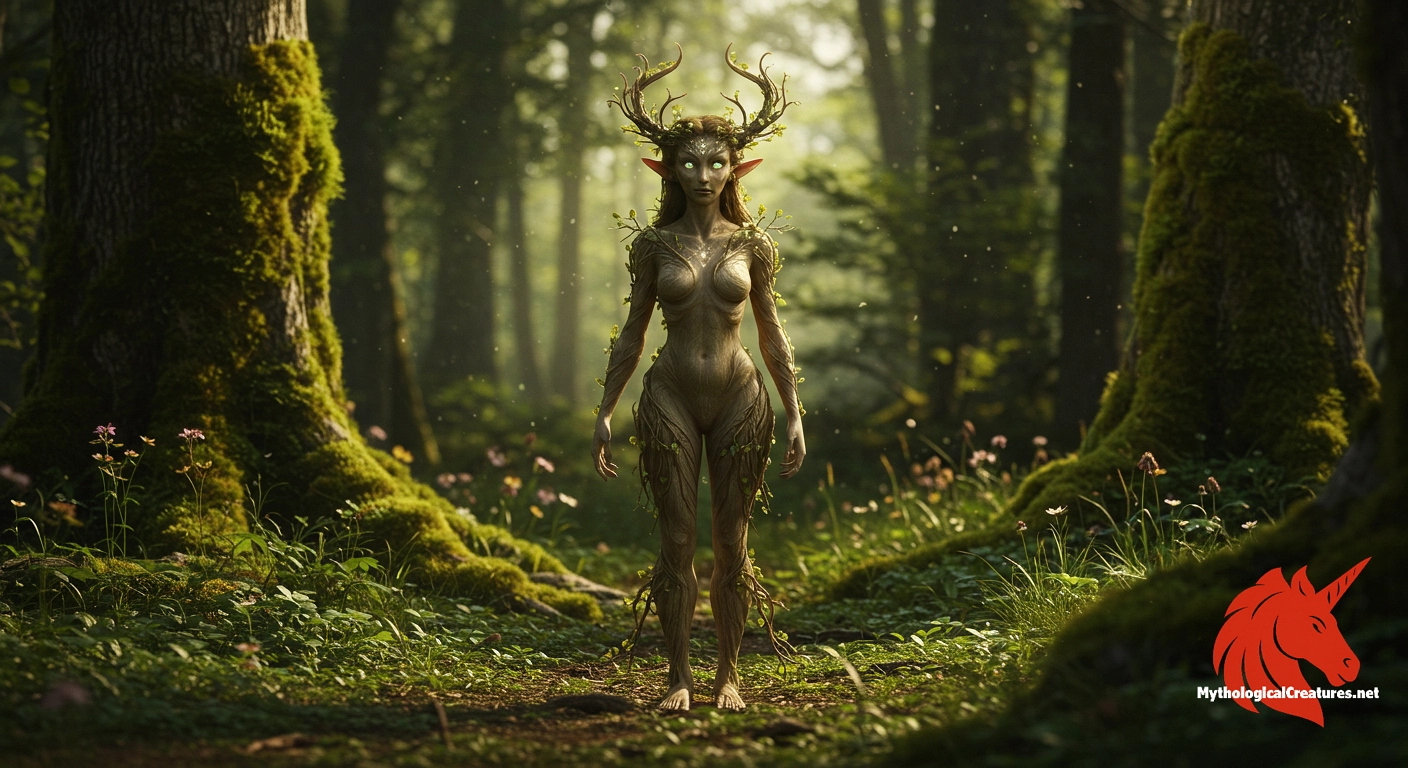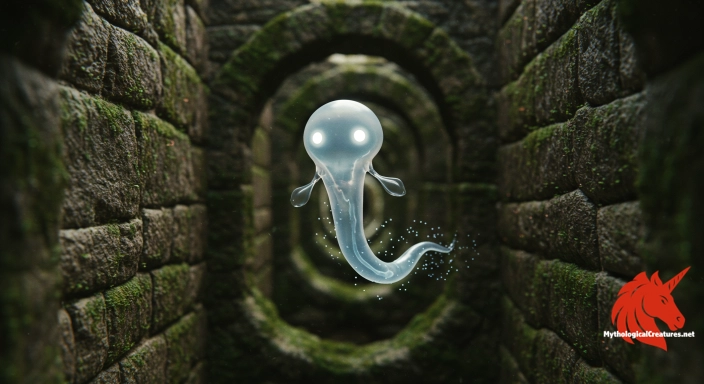Atlanteia: Atlanteia, also known as Atlantia, is a hamadryad nymph in Greek mythology.

Atlanteia
Atlanteia - Atlanteia represents the intertwining of nature and mortals, embodying the mysterious power of the forest and the legacy of royal lineage.
Origins & First Encounters
Atlanteia emerges from the mists of ancient myth as a beguiling Hamadryad nymph whose story is woven tightly into the fabric of Greek tradition. Born of the sacred union between nature and divinity, she is closely associated with the Libyan landscapes that provided both mystery and sustenance to early cultures. Her earliest mentions, though fragmentary, suggest that she was viewed as an embodiment of the living forest, a symbol of nature’s enduring spirit. The narrative of her life is intertwined with that of King Danaus, marking her as a pivotal figure in the tragic saga of the Danaïdes. She is depicted as a nurturing yet enigmatic presence whose lineage not only blessed but also cursed those who descended from her. In a time when myth and nature were inseparable, Atlanteia symbolised the essential link between humanity and the wilderness around it. Her tale reflects the ancient belief in the divine power that resided in trees and natural places. Her myth, rich with both beauty and forewarning, encapsulates the dual essence of nurture and retribution. As a product of both myth and the natural world, Atlanteia continues to resonate as an emblem of the undying connection between nature and myth. Her enduring allure lies in her ability to bridge the mortal and the eternal with a single, enchanted glance.
Source Texts & Tale Variants
Ancient sources provide a tantalising glimpse into the myth of Atlanteia, though her story is interlaced with fragmentary details and variant traditions. The account provided by Apollodorus highlights her role as a consort to King Danaus and suggests that she may have borne several of the infamous Danaïdes. Other narratives, such as those recounted by Hippostratus, offer differing perspectives on the maternal origins of Danaus’s progeny, underscoring the fluid nature of myth. In some traditions, her identity merges with other nature deities like Phoebe, revealing a tapestry of overlapping characters in the lore. These texts, while brief, affirm her standing as a figure of both fertility and ominous fate. The variations in her story evoke the rich diversity of myth-making in the ancient world, where local traditions shaped and reshaped legendary figures. Each source contributes a fragment to the mosaic of her character, blending genealogical detail with symbolic legend. The scant yet evocative references in classical literature invite further interpretation and scholarly reflection. Such multiplicity of sources enriches her myth, allowing for a dynamic understanding of Atlanteia’s significance. Her narrative continues to be pieced together by modern enthusiasts and experts, preserving a legacy that is as enigmatic as it is enduring.
Form & Powers
The physical presence of Atlanteia is as elusive as the whisper of wind through ancient groves, with her form often imagined to evoke the very essence of nature. As a Hamadryad, her body is envisioned as seamlessly entwined with the vitality of the trees, her silhouette both human and arboreal. Her flowing hair is frequently depicted as mirroring the verdant leaves of a flourishing forest, catching sunlight with every graceful movement. The delicate contours of her face suggest a timeless beauty, imbued with the quiet strength and mystery of nature’s cycles. Her eyes, deep and luminescent, seem to reflect the myriad secrets of sun-dappled woodland clearings. Artists have portrayed her skin with a subtle, bark-like texture, evoking the rugged resilience of ancient timber while maintaining an ethereal glow. Often, she is adorned in garments that appear to be woven from petals and ethereal fibres, blurring the boundary between flora and flesh. Her limbs, slender and elegant, mirror the delicate branches of a venerable tree, symbolising both flexibility and endurance. This symbolic portrayal leaves ample room for creative reimagination, resonating with the idea that her physical form is as mutable and timeless as the natural world she epitomises.
Regional Faces
Across different regions of the ancient Mediterranean, Atlanteia’s myth was adapted to reflect local cultural landscapes and environmental landscapes. In parts of Libya and the wider North African realm, she was revered as a potent symbol of natural abundance and the mysterious forces of the wilderness. Greek traditions, meanwhile, emphasise her role as a woodland spirit whose connection to trees fortified her narrative with an aura of ethereal grace. In certain local retellings, her story was intricately linked with that of other nature deities, resulting in a fluid and often syncretic characterisation. Variations of her myth sometimes see her intertwined with figures such as Phoebe, underscoring a regional propensity to merge divine feminine energies. The local adaptations extended beyond mere lineage, casting her in roles that ranged from nurturing guardian of sacred groves to an ominous harbinger of fate. These regional variations demonstrate how the same mythic figure could be reinterpreted to suit different social and ecological contexts. Local artisans and storytellers would infuse her image with elements that resonated with regional flora, lending her a distinctly local hue. Such rich regional diversity ensures that Atlanteia’s legacy is not confined to a single narrative but rather embodies a pan-Mediterranean reverence for nature.
Cultural Parallels
Atlanteia’s narrative finds intriguing parallels with a host of nature-linked figures across various mythological traditions. Much like the renowned dryads of Greek lore, she embodies a close communion with the arboreal realm, her essence echoing the timeless dance between humanity and nature. Similar fabled beings appear in other cultural mythologies, from the Meliae of early Greek accounts to the enigmatic tree spirits in Celtic and Slavic traditions. These comparative figures reveal a shared cultural archetype: divine feminine entities who nurture, protect, and sometimes forewarn the communities that revere them. Her role as both a progenitor and a natural guardian invites comparisons with other maternal deities who blend elements of fertility and retribution. The thematic recurrence of tree spirits across myths reinforces a universal motif in which nature and divinity are inseparably interlinked. Atlanteia’s ability to transcend simple categorisation as merely a nymph or a goddess highlights her multifaceted role in myth. The intertextual echoes between her legend and those of similar deities serve to remind us that ancient cultures across regions often looked to nature for both explanation and inspiration. Her myth is a resonant chord in the broader symphony of nature deities, linking disparate traditions through its universal appeal. This comparative analysis enriches our understanding of how a singular myth can mirror a common, enduring human fascination with the natural world.
Legacy & Modern Evolution
Over the centuries, Atlanteia has evolved from a relatively obscure nymph in fragmented texts to an enduring symbol of nature’s mystique and transformative power. Her once subtle role in genealogy now finds new expression in modern art, literature, and environmental narratives that draw on her intrinsic connection to the natural world. Contemporary reinterpretations often reimagine her as a guardian spirit of the environment, a muse inspiring ecological awareness and artistic creativity. The transformation of her image reflects broader shifts in cultural attitudes towards nature, where the divine and the natural are seen as mutually reinforcing entities. Her portrayal has expanded beyond the ancient tradition to feature in visual media and literary works that explore the intersection of myth and modernity. Festivals and exhibitions occasionally celebrate her legacy, symbolising a continual reawakening of ancient reverence for the land. Scholars and enthusiasts alike have revisited her narrative, finding in it a profound metaphor for the struggles and harmonies of nature in a modern context. Her legacy is now imbued with contemporary significance, echoing current concerns about environmental sustainability and the loss of natural heritage. Through these evolving interpretations, Atlanteia remains a timeless conduit between the mythical past and the present-day quest for ecological balance. In this way, the ancient nymph’s story continues to inspire and captivate, a perpetual reminder of humanity’s deep-rooted connection to the natural world.
Interesting Fact
It is fascinating that Atlanteia, a seemingly minor nymph, plays a crucial role in the complex familial and moral narratives of Greek mythology, highlighting the interconnectedness of nature and royal bloodlines.
Quick Creature Info
Origin:
Associations:
Our Mythic Legendary Rating:

Also Sometimes Known As:
Habitat:
Supernatural Powers:
Physical Attributes:
Abilities:
Behavior:
Lore:
References
Discover Another Mythical Legend You May Not Have Heard Of?
Uncover the mysteries of ancient folklore and expand your knowledge of legendary beings from cultures around the world.
Dare to Meet the Nitus....
Mythical Disclaimer: The images and data on this site are derived from various historical and literary sources, but we have found that many myths often have multiple versions and interpretations across references, sometimes contradictory. As a result, these creature depictions are artistic interpretations—imaginative blends of folklore, legend, and a dash of AI guesswork. Because creature descriptions vary widely, our illustrations and accompanying information represent our best effort to honor mythology while bridging creative gaps. Enjoy these interpretations—just remember, we've done our best to respect the stories and validate available data, but in the realm of mythology, details often shift, imagination leads the way, and nothing is ever set in stone!
Curated by the Mythological Creatures Team (rev. May 2025)
